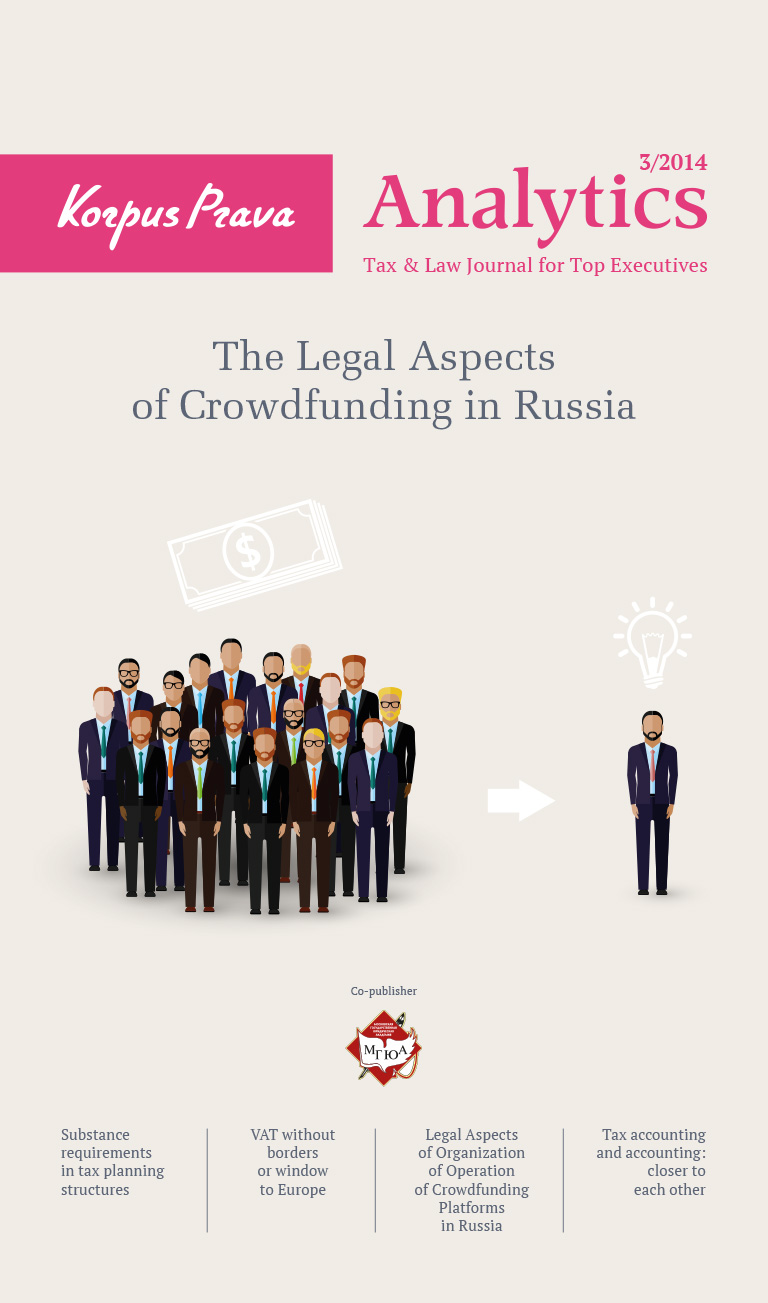- Cyprus Citizenship Scheme for Foreign Investors
- Squeezed But Pleased: Taxation of Passive Income in the European Union
- VAT Without Borders or Window to Europe
- Legal Aspects of Organization of Operation of Crowdfunding Platforms in Russia
- Substance Requirements in Tax Planning Structures
- “Deposit Splitting” of Individuals. Legal Civil and Criminal Aspects
There Is No Money, But You Hang In There!
On July 30, 2017 the law that came in force tightening the procedure for bringing controlling parties to subsidiary liability (Federal Law No. 266-ФЗ dated 29.07.2017).
The current legislation of the Russian Federation allows bringing parties controlling the debtor to subsidiary liability in certain cases of company’s insolvency.
However, pursuant to the general rule the director general and the shareholder (holding more than 50% of shares in the authorised capital) shall be considered parties controlling the debtor[1]. In particular cases the court may identify other persons as controlling parties (chief accounting officer, chief financial officer, other officers, or the actual beneficiary, in case the director/founder of the debtor claims that he/she is a nominal beneficiary and reveals the information on the actual beneficiary[2]).
Application period for bringing to subsidiary liability equals three years from the date when a person entitled to file such application learned or had to learn the relevant causes for bringing to subsidiary liability, but not later than three years from the date the debtor was recognized a bankrupt (discontinuance of bankruptcy proceedings or return of the bankruptcy petition to a competent authority), and not later than ten years from the day when actions and/or omissions deemed as causes for bringing to subsidiary liability took place[3].
Cause 1
Subsidiary liability for failure to settle fully creditors’ claims due to actions and/or omissions of controlling parties.
Causes for bringing to liability
In case of failure to settle fully creditors’ claims due to actions or omissions of a party controlling the debtor, such party shall bear subsidiary liability for the debtor’s obligations[4]. Until proven otherwise, full settlement of creditors’ claims is deemed impossible due to actions or omissions of party controlling the debtor under at least one of the following circumstances:
- Significant damages were caused to creditors’ property rights due to the performance of one or several debtor’s transactions (performance of such transactions by order of this person) by this person or on behalf of this person, or upon approval of this person;
- By the determination date of supervision introduction (or by the appointment date of the temporary administration for the financial organization), accounting records and/or statements, that shall be maintained (issued) and kept in accordance with the legislation of the Russian Federation, are missing or contain no information prepared under the legislation of the Russian Federation on the issues stipulated by the legislation of the Russian Federation, or the said information is corrupted and hinders application of bankruptcy procedures, including formation and disposal of bankruptcy assets;
- Claims of third-priority creditors under the outstanding principal amount resulting from the law violation punishable by criminal, administrative or tax prosecution of the debtor or its officials that act or acted as its sole executive body, according to the court order that came into force, including payment request of the debt revealed during proceedings in these cases, do not exceed fifty percent of the total amount of third-priority creditors’ claims for the outstanding principal amount that are registered in the list of creditors;
- By the determination date of supervision introduction (or by the appointment date of the temporary administration for the financial organization), documents which shall be kept in accordance with the legislation of the Russian Federation on joint-stock companies, on securities market, on investment funds, on limited liability companies, on state and municipal unitary companies and legal acts adopted thereunder, are missing or corrupted;
- As of the initiation date of bankruptcy proceedings no obligatory entry has been made into the Unified State Register of Legal Entities under the federal law or misleading information has been entered in accordance with the documents submitted by this legal entity;
- Failure to settle creditors’ claims resulted from actions and/or omissions of a party controlling the debtor, but bankruptcy proceedings were terminated due to the absence of money to cover legal expenses for the bankruptcy case, or return of the bankruptcy petition to a competent authority;
- The debtor was qualified for insolvency for a different reason rather than actions and/or omissions of a party controlling the debtor, which later performed an action and/or omission that aggravated the debtor’s financial state.
In case of failure to settle fully creditors’ claims due to actions or omissions of several parties controlling the debtor, such parties shall jointly bear subsidiary liability.
Terms of release from subsidiary liability
A party controlling the debtor whose actions and/or omissions lead to failure to settle fully creditors’ claims shall not bear subsidiary liability, if it proves absence of its fault in failure to fully settle creditors’ requirements. Such persons shall not bear subsidiary liability if they acted under conditions of civil-law transactions, reasonably and in good faith on behalf of the debtor, their founders (members), complying with creditors’ property rights, and if they prove that their actions prevented a more significant damage to the creditors’ interests.
Extent of subsidiary liability
Extent of subsidiary liability for a party controlling the debtor shall equal the total amount of creditors’ claims that are registered in the list of creditors’ requirements, creditors’ requirements filed after the closure of the list, and creditors’ claims for the current outstanding payments due to insufficient assets of the debtor. Extent of subsidiary liability for a party controlling the debtor is subject to reduction, if it will be able to prove that the amount of damage incurred to the creditors’ property rights through this person’s fault is significantly less that the amount of claims subject to settlement at the expense of this person with significant control over the debtor.
Cause 2
Subsidiary liability for failure to file (untimely filing of) the debtor’s application.
Causes for bringing to liability
Director’s obligations: Debtor’s director shall file the debtor’s application to the arbitration court as soon as practicable, but not later than one month from the date of one of the following circumstances[5]:
- The settlement of claims made by one or several creditors causes inability of the debtor to fulfill in full its financial obligations or obligations for mandatory and/or other payments to other creditors;
- The debtor’s body duly authorized under its incorporation documents to pass resolutions on the debtor’s liquidation has decided to file the debtor’s application to the arbitration court;
- The execution upon the debtor’s property will significantly hinder or prevent business activities of the debtor;
- The debtor meets the criteria for insolvency and/or property insufficiency;
- Due to insufficient funds there is more than three-month outstanding severance pay, wages and other payments to an employee or former employee in the amount and manner stipulated by the labour legislation.
Founder’s obligations: unless the debtor’s director files the debtor’s application to the arbitration court within the abovementioned period and remedies irregularities causing legal action within 10 calendar days from the termination of this period, the founder shall demand convocation of the extraordinary general meeting of the debtor’s members to resolve on filing the bankruptcy petition to the arbitration court, which shall be held not later than ten calendar days from the notification of its convocation. The general meeting of members (sole member) shall resolve on filing the self-bankruptcy petition to the arbitration court, unless these irregularities are remedied as of the date of the meeting.
Failure to file the debtor’s application to the arbitration court (convene the meeting to resolve on filing the debtor’s application to the arbitration court or pass such resolution), as cases may be, in the specified period shall be punishable by the subsidiary liability of the director and the founder[6].
Upon violation of the said obligation by several persons, these persons shall be held jointly liable.
Terms of release from subsidiary liability
In case failure to settle creditor’s claims and failure to file the self-bankruptcy petition to the arbitration court have no causal connection, a controlling party may be released from subsidiary liability. However, the person (persons) brought to liability shall be responsible for proving the absence of such causal connection.
Extent of subsidiary liability
Extent of liability shall equal the amount of debtor’s obligations arising after the end date of the period set out for filing an application by the director (1 month from the relevant circumstances) and convocation of the meeting by the founder (1 month + 10 days), and before the initiation of the debtor’s bankruptcy proceedings[7].
Extent of liability under this article shall not include those obligations that arose before the claimant in bankruptcy learned or had to learn the causes for obligations stipulated by Article 9 of the current Federal Law, except for requests for obligatory payments and requirements under obligatory contracts for the debtor’s counterparty.
Cause 3
Liability (indemnification) for violation of bankruptcy legislation.
Causes for bringing to liability
In case of violation of the bankruptcy legislation by the debtor’s director or founder, the said persons shall reimburse the losses incurred due to such violation.
Thus, if the debtor filed the debtor’s application to the arbitration court while being able to fully settle creditors’ claims, or the debtor took no measures to appeal against unreasonable claims of the applicant or creditors’ claims in the bankruptcy case, parties controlling the debtor shall be held liable for the losses ensuing from the initiation of bankruptcy proceedings or unreasonable acceptance of creditors’ claims.
The same principles apply in cases when the debtor fails to appeal against unreasonable creditors’ claims filed before or after the initiation of bankruptcy proceedings, beyond bankruptcy proceedings.
The summary is represented in the table below:


Paragraph 4, Article 61.10 of Federal Law No. 127-ФЗ dated 26.10.2002 On Insolvency (Bankruptcy).
Paragraph 9, Article 61.11 of Federal Law No. 127-ФЗ dated 26.10.2002 On Insolvency (Bankruptcy).
Paragraph 5, Article 61.14 of Federal Law No. 127-ФЗ dated 26.10.2002 On Insolvency (Bankruptcy).
Paragraph 1, Article 61.11 of Federal Law No. 127-ФЗ dated 26.10.2002 On Insolvency (Bankruptcy).
Paragraphs 1, 2, Article 9 of Federal Law No. 127-ФЗ dated 26.10.2002 On Insolvency (Bankruptcy).
Paragraph 1, Article 61.12 of Federal Law No. 127-ФЗ dated 26.10.2002 On Insolvency (Bankruptcy).
Paragraph 2, Article 61.12 of Federal Law No. 127-ФЗ dated 26.10.2002 On Insolvency (Bankruptcy).
Your subscription to our journal will definitely boost the efficiency of your specialists and downsize your expenses for consultants.
The journal is available free of charge in the electronic version.
Free Download

